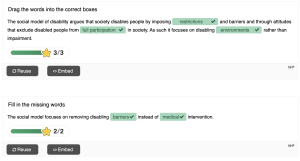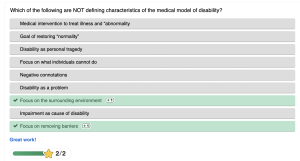5
Section one: The fundamentals
A)
Exercise 1: Notebook Prompt
Many of you are likely familiar with the concept of “ability inequity,” which the authors of this article define as “an unjust or unfair (a) ‘distribution of access to and protection from abilities generated through human interventions’ or (b) ‘judgment of abilities intrinsic to biological structures such as the human body’.”
However, they go on to identify the following “ability concepts” that are less familiar:
1) ability security (one is able to live a decent life with whatever set of abilities one has)
2) ability identity security (to be able to be at ease with ones abilities)
How prevalent are these forms of security among disabled people you know? Or, if you identify as a disabled person, would you say your social surroundings and community foster and support these kinds of security? Furthermore, while the focus of the article is on Kinesiology programs, it is also important to reflect on how academia in general accommodates for disability. If you feel comfortable answering this question, what has been your experience of postsecondary education to date?
-OR-
The authors also observe that “Ableism not only intersects with other forms of oppression, such as racism, sexism, ageism, and classism, but abilities are often used to justify such negative ‘isms’.”
What do you think this means? Provide an example.
|
I think that this is a tough question and can range expansively. I have worked with many people with disabilities. I will say for the most part that these people have been happy and healthy and continue to do the things that they love to do like any other person. They are not dissatisfied with their lives at all. There is however another group that I have also worked with where this has come as more of a surprise forced upon them at an older age, the life that they once knew is now no more and the ability to transfer one to the other yields less on the ability identity security. I have seen them move mountains and regain some strength or learn to speak again in small sentences, but reaching them in the way that touches their soul for lack of a better word is nearly impossible to do. My experience with academia thus far has been pleasant and without any issues. I do however lack any impeding factors to my education at this time. |
Exercise 2: Implicit Bias Test
Did anything surprise you about the results of the test? Please share if you’re comfortable OR comment on the usefulness of these kinds of tests more generally.
| I think this test felt odd if anything. Once I completed the test came back that I showed a slight automatic preference for abled over disabled persons. I am not sure if at the end that makes me a bad person or not either. The way that they coupled the photos and negative words felt wrong while I was completing it, I suppose the whole point of the test however. |
B) Keywords
Exercise 3:
Add the keyword you contributed to padlet and briefly (50 words max) explain its importance to you.
|
The social model of disability is seen in terms of the societal expectations in terms of creating a fully accessible living for all. In this way you can see that in contrast to the medical model where the focus is on the individual and what they need specifically, the focus here is on changing society so that is no longer required. The significance is placed on the altering the practices, view points, and physical barriers. |
B) On Disability
Exercise 4: Complete the Activities


Exercise 5: Notebook Prompt
What do Fitzgerald and Long identify as barriers to inclusion and how might these apply to sport in particular?
Long and Fitzgerald break this down into reviving both the medical and social models of disability. Socially there is historically negative ideologies around disabled people and what they are capable of doing that ultimately leads to them being excluded. There is also societal barriers such as lack of accessibility and marginalization that hinders people from feeling like they are allowed to participate. They spoke about how there is a focus on sport in terms what someone may not be able to do in terms of their disability, rather than the positive impacts that it can have on the body regardless of playing level. The ability to create more accessible communities and change the focus to the positives that sports can bring would be the ultimate goal.
C) Inclusion, Integration, Separation
Inclusion
Exercise 6: Complete the Activities
Exercise 7: Notebook Prompt
Choose ONE of the three questions Fitzgerald and Long argue disability sport needs to address and record your thoughts in your Notebook.
- Should sport be grouped by ability or disability?
- Is sport for participation or competition?
- Should sport competitions be integrated?
|
I think that sport should be able to be both for participation and competition. There are obviously great benefit from participating in sport including better all around health, team work, and improved socialization skills. That being said the structure from a competitive league can also help to build skill sets and foster personal goals and self perception. The issues is generally the ability to find the balance between each, and choosing the correct level that you would like to play within. |
Part Two: Making Connections
A) Gender, Sport and Disability
Exercise 8: Complete the Activity
The paradox that sportswomen habitually face (as the authors observe, this isn’t confined to disabled sportswomen) involves the expectation they will be successful in a ‘masculine’ environment while complying with femininity norms in order to be recognized as a woman.
True –
Take a moment to reflect on this paradox below (optional).
B) Masculinity, Disability, and Murderball
Exercise 9: Notebook/Padlet Prompt
Watch the film, Murderball and respond to the question in the padlet below (you will have an opportunity to return to the film at the end of this module).
The authors of “Cripping Sport and Physical Activity: An Intersectional Approach to Gender and Disability” observe that the “gendered performance of the wheelchair rugby players can…be interpreted as a form of resistance to marginalized masculinity” (332) but also point out that it may reinforce “ableist norms of masculinity.” After viewing the film, which argument do you agree with?
a) Murderball celebrates a kind of resistance to marginalized masculinity
| I think that Murderball reinforces both of these things. You can see how this sport is very competitive, high paced, and intense which conforms to that ableist norms of masculinity. The resistance to marginalized masculinity is seen in that these men are all quadriplegic and yet living a very fulfilling active life within a highly competitive sporting league. |
Section Three: Taking a Shot
A) Resistance
B) Calling out Supercrip
Exercise 10: Mini Assignment (worth 5% in addition to the module grade)
1) Do you agree with the critique of the “supercrip” narrative in this video? Why or why not? Find an example of the “supercrip” Paralympian in the 2024 Paris Paralympics or Special Olympics coverage and explain how it works.
| Supercrip is showing that people are overcoming their disabilities to be able to do something great or extraordinary. The clip shows people with various disabilities the focus is on that they can complete these goals regardless of them. I think in that way it would follow the supercrip narrative. The video does seem to portray that sense of overcoming an obstacle rather than focusing on the achievements.
I am unable to find an exact clip to utilize for this answer. The idea however is that their disability is what is being reported on rather than the individual talent. That overcoming of something in order to be seen as great when they activity it self should be what matters. |
2) Does the film Murderball play into the supercrip narrative in your opinion? How does gender inform supercrip (read this blog for some ideas)?
(300 words for each response)
|
The film Murder Ball does seem to fit into the supercrip narrative. The film shows the game of wheelchair rugby which is high paced and intense with plenty of opportunity for injury. They show the intense competitive nature of it by starting with Canada wining over the US who had won every year since. They then begin to spend time on the athletes themselves and some of their personal stories. The way that it is portrayed is in terms of learning to overcome their disability within the sport of wheelchair rugby. The film places emphasis on this fact that it is exceptional that they can be so resilient and overcome their disabilities in becoming extraordinary athletes within their sport. The aspect of gender plays a role here in that it becomes two fold. The portrayal here is now not only that they are able to compete in a high intensity sport, but that sport is also very masculine in nature. The story line here has an undertone that they are indeed masculine enough or man enough. They speak about women and their needs and then take part in high intensity sport. In that way they work to depict that despite their disabilities they are able enough and they are man enough.
|

